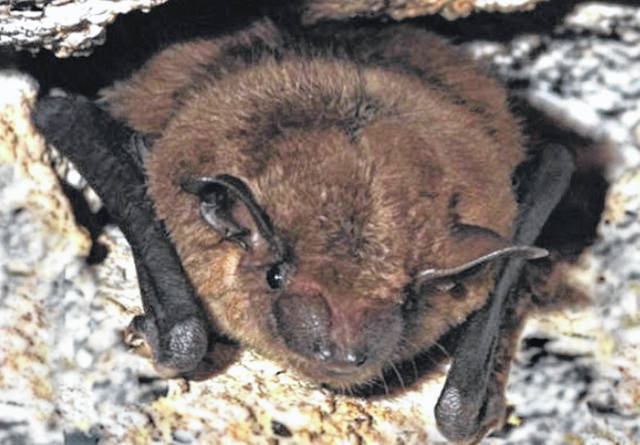
Here in Ohio we are blessed to have some of the most beautiful natural landscapes filled with countless breathtaking examples of unique wildlife. The wildlands of the state are full of forests, streams and rivers, waterfalls, and stunning caves.
When taking a closer look, we have the opportunity to admire the wildlife which inhabits these environments — eagles, owls, deer, coyotes, raccoons, opossums, and skunks, just to name a few. All stunning and unique examples of proud Ohio wildlife.
If you keep your lookout sharp and are outside at the right times, you may even encounter one of our state’s most specialized creatures. They are the planet’s only mammal capable of flight, they hunt using sound and, despite being barely larger than a mouse, can live up to four decades.
This amazing animal is the bat.
There are 14 species of bats here in Ohio that come in a wide variety of shapes, colors, and sizes, but they all have a lot in common. Every one of our bat species are insectivores, meaning they exclusively consume insects.
Their diet includes harmful bugs such as mosquitoes, flies, destructive beetles, and other flying pests. A single bat can consume up to their body weight in insects on any given night, which could be several thousand bugs.
Bats are one of them most important animals in the state of Ohio in insect population control.
One thing you may have noticed is that bats seemingly only come out on warm summer nights. This is an evolutionary adaptation that helps them find the most insects.
A good rule of thumb to remember is, when bugs are out, bats are out; but where do they go during the colder portions of the year?
This answer varies by species; some bats migrate south and feed year-round while others will hibernate here in Ohio.
During the warmer months bats prefer to stay away from people, they usually inhabit caves or areas of dense tree cover. A place that is quiet, dark, and safe from predators is where they prefer to spend their days.
Recently however, two of Ohio’s bat species — the Little Brown and the Big Brown — have begun entering people’s attic spaces and wall voids looking for shelter. They do this through natural construction gaps, and because of how non-destructive and quiet they are.
Bats have the potential to go years or even decades living in a home before ever being noticed.
None of Ohio’s bats will attack you. They are some of the most docile animals in the state.
They recognize how big and scary people are and will rely on camouflage to stay hidden if we get too close.
Bats have a poor reputation in many cultures, a lot of people fear them or call them flying rats. This fear is misguided and leads to irrational phobias. People who fear bats argue that they carry life-threatening diseases such as rabies, a real and terminal disease spread from animal to animal through bodily fluids such as saliva.
Bats along with most every other mammal in the state can carry rabies, but you must remember the odds of this are exceptionally low. Throughout the past five years, about 3 percent of tested bats in Ohio have been positive for rabies.
Yet even with these figures it is important to note that you have a greater likelihood of being struck by lightning twice than you do of being bitten by a rabid bat.
Most bites that occur happen when people try to grab them with their bare hands. Though they are docile and almost certainly harmless, you should never attempt to touch a bat.
Every year thousands of Ohio residents will notice a bat in their house. The best thing you can do in this situation is attempt to contain the bat in one room leaving a door or window open so that it may go outside on its own.
Bats are extremely intelligent and most of the time will find their own way out. Even if you believe the bat did not come into contact with anyone in the home, it is best to contact a medical professional and explain the situation to them, always follow a doctor’s recommendations.
Lastly, it is recommended you also call a specialty bat control company to come inspect your home. It is extremely rare for a bat to inadvertently fly in through a window, door, or chimney; what usually happens is one of the members of a family of bats living in the home will accidentally leave a wall void and enter a living space such as an unfinished basement.
Once the bat is safely removed or contained, the next step from here would be removing the bats from the home, which is executed through the use of one-way exits. Wildlife professionals do not kill your bats, they remove them from the home so they may find somewhere else to live.
Ohio’s bats are beautiful and impactful creatures who are critical to our ecosystem with their insect population control.
Human urbanization has been negatively affecting our bats as well as every other native species more and more with every passing year. Habitat loss, traffic accidents, and pollution are ravishing our state’s wildlife. Awareness is crucial before anything can be done to fix this.
It is our jobs as people to learn to live with nature instead of against it. If you encounter a bat or any other type of wild animal in or around your home, leave it alone. Give it the opportunity to leave.
If you want to help your bats even more-so, try installing a bat house on your property.
There a dozens of great do-it-yourself ideas online.
We have to do this because only we can keep Ohio beautiful and it is our duty to do so.
Alex Tillapaugh is 2018 graduate in biology from Wilmington College. He is currently working on a master’s degree in biology through Miami University.


